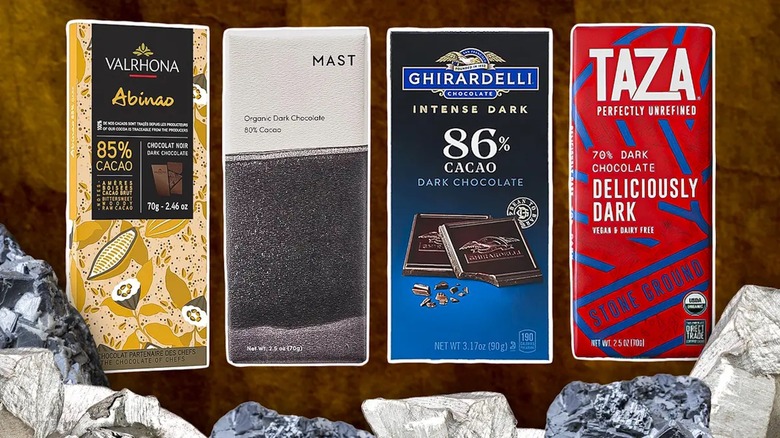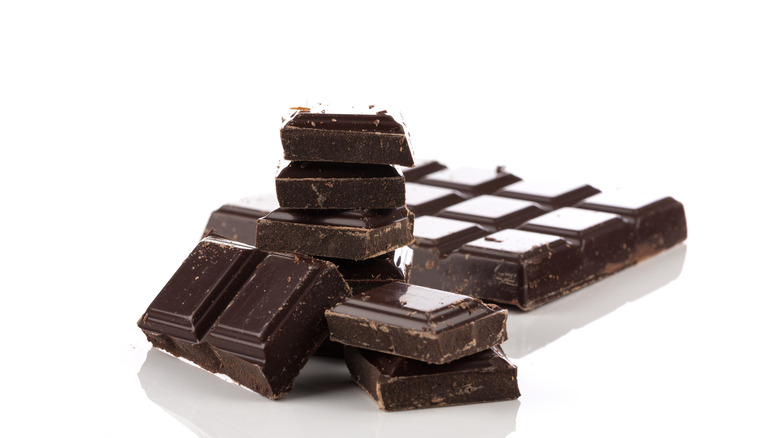The Dark Chocolate Brands With The Lowest Lead And Cadmium Levels
Perhaps you're one of the many people who've switched from milk to dark chocolate because the latter has less sugar and more antioxidants. But before you tear into that candy bar or hit the kitchen to start cooking up a homemade treat (like our salted caramel recipe), there's something you should know. Your dark chocolate may be hiding an even darker secret. It's known to contain two heavy metals — cadmium and lead — that can cause harmful health effects. Pregnant people and children are at higher risk.
There have been several scientific studies that found both of these heavy metals in various samples of dark chocolate the researchers tested, and a 2023 Consumer Reports study found that levels in some brands exceeded California's maximum recommended amounts for one or both of the elements. There are a few options with lower amounts, the best-known being Ghirardelli. Other brands, including two organic options, Mast and Taza Chocolate, also make the list of safer choices. Although celebrity cook Ina Garten swears by Lindt chocolate in her recipes, Consumer Reports found the brand's dark chocolate had cadmium levels above California's maximum allowable dose level. But how the heck does cadmium and lead end up in dark chocolate anyway?
Why there's cadmium and lead in dark chocolate
Lead accumulation in the body can create a range of health issues, from nervous system problems to kidney and liver damage, according to a 2020 scientific paper in the Journal of Health Science and Engineering. In children, it can lead to lower IQ and learning issues. Cadmium accumulation in the body can cause various cancers, and both of these heavy metals can also affect the immune system. Cadmium typically ends up in chocolate through the soil that the cacao tree — the beans of which are the main ingredient in chocolate — grows in. Lead may find its way into cacao when it's being harvested or processed.
The 2023 Consumer Reports study found the two heavy metals in all 28 dark chocolate bars it tested, with some products having levels of both lead and cadmium exceeding the recommended dose thresholds of 0.5 micrograms for lead and 4.1 for cadmium. Similarly, a 2024 Frontiers in Nutrition study discovered that in the 72 dark chocolate products it tested, 43% contained higher levels of lead and 35% had higher levels of cadmium considered safe. Because there is no national standard for allowable amounts of lead and cadmium in most food, both studies relied on California's state guidelines. Neither study looked at milk chocolate, which tends to have lower levels of heavy metals than dark chocolate, which contains more cacao.
The safest choices
By far the best known brand that Consumer Reports found to have lower levels of both cadmium and lead is Ghirardelli. It made the safer choices list with two of its bars — Intense Dark Chocolate and Intense Dark Chocolate Twilight Delight. Valrhona's Abinao Dark Chocolate also made the list. While the George Washington University study found that the organic products tended to have higher levels of the two heavy metals, Mast's Organic Dark Chocolate and Taza Chocolate's Organic Deliciously Dark Chocolate rounded out the only five bars in Consumer Reports' list that fell below the thresholds for both lead and cadmium.
Dark chocolate may be seriously overrated anyway, since the health benefits of high-cacao chocolate don't eclipse its often unpalatable bitterness. But if you're into dark chocolate, don't worry — a third recent study from New Orleans' Tulane University published in Food Research International in 2024 determined that eating 1 ounce of dark chocolate a day "poses no adverse risk for adults" and only a slight risk for children. It should be noted this study didn't rely on California's more conservative guidelines as the others did. Even so, you may be better off going with the brands that have lower levels of these heavy metals.


